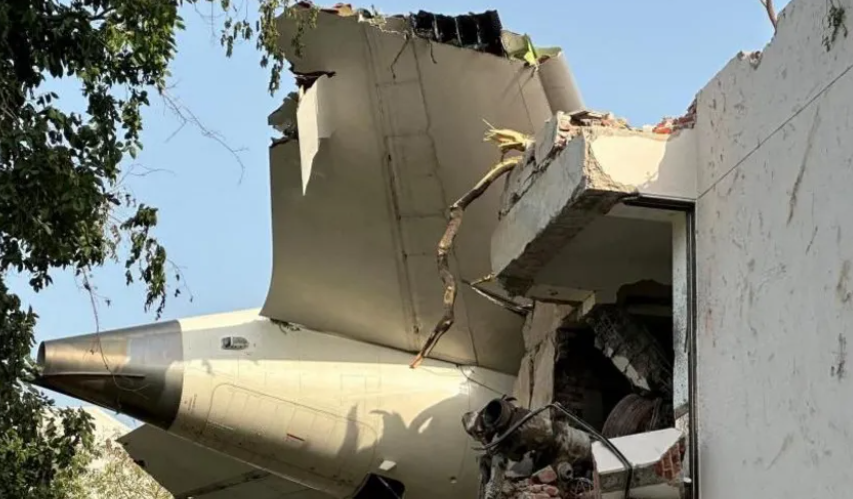Why cockpit audio deepens the mystery of Air India crash - MyJoyOnline
Just seconds after takeoff, both the 12-year-old Boeing 787 Dreamliner's fuel-control switches abruptly moved to the "cut-off" position, starving the engines of fuel and triggering total power loss. Switching to "cut-off" is a move typically done only after landing.
The cockpit voice recording captures one pilot asking the other why he "did the cut-off", to which the person replies that he didn't. The recording doesn't clarify who said what. At the time of takeoff, the co-pilot was flying the aircraft while the captain was monitoring.
The switches were returned to their normal inflight position, triggering automatic engine relight. At the time of the crash, one engine was regaining thrust while the other had relit but had not yet recovered power.
Air India Flight 171 was airborne for less than 40 seconds before crashing into a crowded neighbourhood in the western Indian city of Ahmedabad, marking one of India's most baffling aviation disasters.
Investigators are probing the wreckage and cockpit recorders to understand what went wrong just after takeoff. The Air India flight climbed to 625 feet in clear weather before losing location data 50 seconds in, per Flightradar24. Saturday's 15-page report offers early insights.
The investigation - led by Indian authorities with experts from Boeing, General Electric, Air India, Indian regulators, and participants from the US and UK - raises several questions.
Investigators say the lever-lock fuel switches are designed to prevent accidental activation - they must be pulled up to unlock before flipping, a safety feature dating back to the 1950s. Built to exacting standards, they're highly reliable. Protective guard brackets further shield them from accidental bumps.
"It would be almost impossible to pull both switches with a single movement of one hand, and this makes accidental deployment unlikely," a Canada-based air accidents investigator, who wanted to remain unnamed, told the BBC.
That's what makes the Air India case stand out.
Investigators have uncovered a chilling discovery in the preliminary investigation into the Air India Flight 171 crash which killed 260 people in June.
Just seconds after takeoff, both the 12-year-old Boeing 787 Dreamliner's fuel-control switches abruptly moved to the "cut-off" position, starving the engines of fuel and triggering total power loss. Switching to "cut-off" is a move typically done only after landing.
The cockpit voice recording captures one pilot asking the other why he "did the cut-off", to which the person replies that he didn't. The recording doesn't clarify who said what. At the time of takeoff, the co-pilot was flying the aircraft while the captain was monitoring.
The switches were returned to their normal inflight position, triggering automatic engine relight. At the time of the crash, one engine was regaining thrust while the other had relit but had not yet recovered power.
Air India Flight 171 was airborne for less than 40 seconds before crashing into a crowded neighbourhood in the western Indian city of Ahmedabad, marking one of India's most baffling aviation disasters.
Investigators are probing the wreckage and cockpit recorders to understand what went wrong just after takeoff. The Air India flight climbed to 625 feet in clear weather before losing location data 50 seconds in, per Flightradar24. Saturday's 15-page report offers early insights.
The investigation - led by Indian authorities with experts from Boeing, General Electric, Air India, Indian regulators, and participants from the US and UK - raises several questions.
Investigators say the lever-lock fuel switches are designed to prevent accidental activation - they must be pulled up to unlock before flipping, a safety feature dating back to the 1950s. Built to exacting standards, they're highly reliable. Protective guard brackets further shield them from accidental bumps.
"It would be almost impossible to pull both switches with a single movement of one hand, and this makes accidental deployment unlikely," a Canada-based air accidents investigator, who wanted to remain unnamed, told the BBC.
That's what makes the Air India case stand out.
The Views, Comments, Opinions, Contributions and Statements made by Readers and Contributors on this platform do not necessarily represent the views or policy of Multimedia Group Limited.
The Views, Comments, Opinions, Contributions and Statements made by Readers and Contributors on this platform do not necessarily represent the views or policy of Multimedia Group Limited.
You may also like...
Diddy's Legal Troubles & Racketeering Trial

Music mogul Sean 'Diddy' Combs was acquitted of sex trafficking and racketeering charges but convicted on transportation...
Thomas Partey Faces Rape & Sexual Assault Charges

Former Arsenal midfielder Thomas Partey has been formally charged with multiple counts of rape and sexual assault by UK ...
Nigeria Universities Changes Admission Policies

JAMB has clarified its admission policies, rectifying a student's status, reiterating the necessity of its Central Admis...
Ghana's Economic Reforms & Gold Sector Initiatives

Ghana is undertaking a comprehensive economic overhaul with President John Dramani Mahama's 24-Hour Economy and Accelera...
WAFCON 2024 African Women's Football Tournament

The 2024 Women's Africa Cup of Nations opened with thrilling matches, seeing Nigeria's Super Falcons secure a dominant 3...
Emergence & Dynamics of Nigeria's ADC Coalition

A new opposition coalition, led by the African Democratic Congress (ADC), is emerging to challenge President Bola Ahmed ...
Demise of Olubadan of Ibadanland
Oba Owolabi Olakulehin, the 43rd Olubadan of Ibadanland, has died at 90, concluding a life of distinguished service in t...
Death of Nigerian Goalkeeping Legend Peter Rufai

Nigerian football mourns the death of legendary Super Eagles goalkeeper Peter Rufai, who passed away at 61. Known as 'Do...





